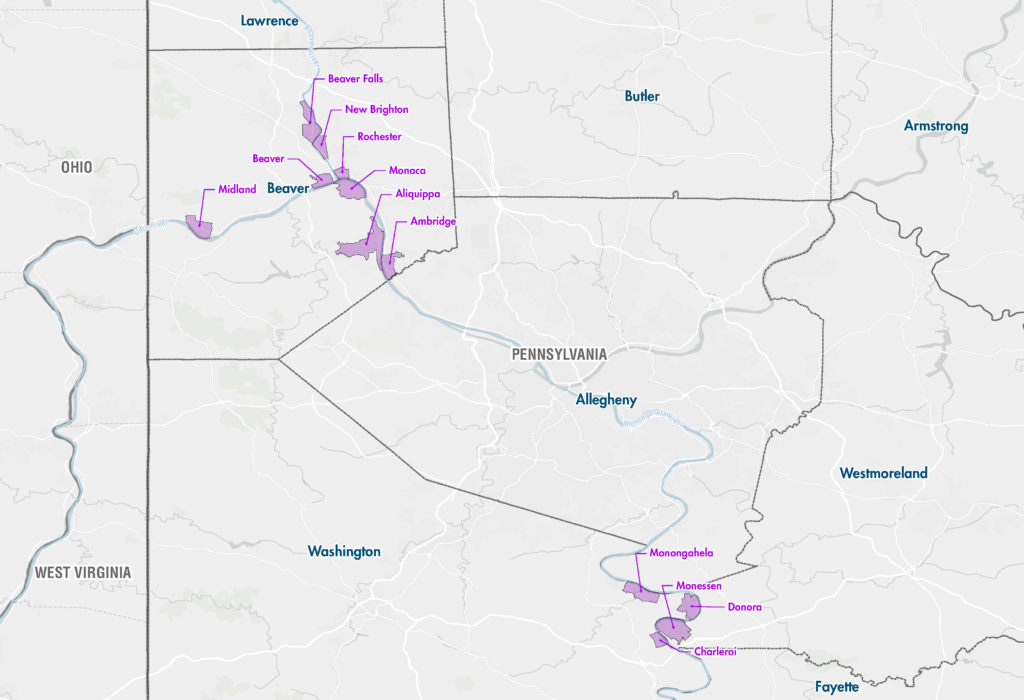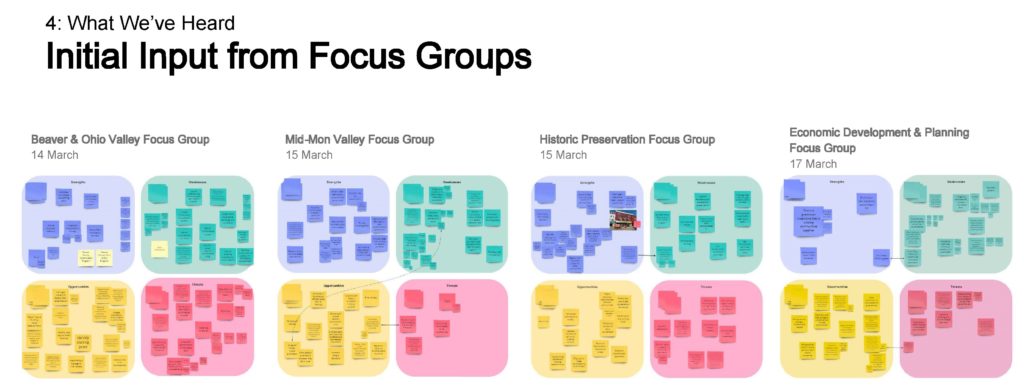As we wrote about in a recent blog post, the Pennsylvania State Historic Preservation Office (PA SHPO) has been working on a huge project in our western region, aimed at identifying the challenges and opportunities for historic preservation and economic revitalization in smaller deindustrialized communities, focusing on twelve riverfront municipalities located within two regions of Southwestern Pennsylvania.
Each of the 12 communities (Ambridge, Aliquippa, Beaver, Beaver Falls, Midland, Monaca, New Brighton, Rochester in Beaver County in the Ohio and Beaver River Valley) and Charleroi, Donora, Monessen, and Monongahela in Washington and Westmoreland Counties in the Monongahela River Valley) has its own unique history, a unique set of historic resources, and a unique set of challenges as it pursues economic revitalization and vitality.

One overall goal for this project is to identify ways for communities to leverage their older, historic commercial business districts and key historic buildings as part of an overall economic development strategy, both individually and as a region. Integral to this process is the solicitation and incorporation of feedback from the community and stakeholders about the challenges and opportunities for redevelopment.
As you may remember from this post, this project is one of the mitigation measures included the Programmatic Agreement related to the construction of a petrochemical plant along the Ohio River in Beaver County. The project triggered consultation pursuant to Section 106 of the National Historic Preservation Act. Consultation was initiated due to Shell Chemical Appalachia’s (Shell) need for a permit from the United States Army Corps of Engineers.
Public Engagement Strategy
As part of this effort, PA SHPO and its consultant team of AKRF and evolve environment::architecture have undertaken a robust public engagement strategy including stakeholder interviews, public meetings, and online engagement. One of the key components of this process was to invite stakeholders to one or more of four virtual focus group sessions: 1) Beaver & Ohio River Valley (March 14); 2) Mon Valley (March 15); 3) Historic Preservation (March 15); and 4) Economic Development and Planning (March 17).
Through this process, we have heard from the Pennsylvania Department of Community and Economic Development (PA DCED) Center for Local Government Services, Rivers of Steel National Heritage Area, Mon Valley Alliance, Monongahela Main Street, National Road Heritage Corridor, Redevelopment Authority of the County of Westmoreland, Washington County Planning Department, Old Economy Village Historic Site, Ambridge Historic and Architecture Review Board, Ambridge Historic District Economic Development Corporation, Beaver County Regional COG, RiverWise, and others.
We were fortunate to have roughly 25 attendees at each focus group session. During each focus group, participants were encouraged to answer key research questions to engage in a strengths, weaknesses, opportunities, and threats (SWOT) analysis using Miro—a visual collaboration platform that allows comments to be captured in real time.

What We’ve Heard:
Beaver and Ohio River Valley Focus Group:
- Beaver County has existing programs in place to support investment in downtowns.
- Grassroots local investment is strong and there are strong signs of entrepreneurship in these communities.
- Lack of code enforcement allows absentee landlords’ properties to fall into disrepair.
- Compliance with building codes can be challenging.
- Beaver County communities in this study benefit from belonging to the same county.

Mon Valley Focus Group:
- Donora and Monessen communities have largely intact downtowns with architectural significance but many of the buildings are vacant. Second floor spaces are frequently vacant in all four Mon Valley communities.
- Downtown riverfront connection is an opportunity for improvement.
- Being split between two counties can present challenges for coordination between the communities.
- Cultivating a regional Mid-Mon Valley identity, while celebrating what makes each community unique, is an opportunity to change perceptions of these communities.
- Communities with successful main streets can serve as models for other communities.

Historic Preservation Focus Group:
- Communities with established historic districts can serve as an example for other communities to follow.
- In the Beaver and Ohio River Valley study area region, both Beaver and Ambridge have local historic districts in addition to historic districts listed in the National Register of Historic Places.
- None of the communities in the Mon Valley study area region have locally-listed districts but Charleroi has an extensive National Register-listed historic district.
- If investments in stabilization aren’t made soon, some buildings could deteriorate beyond repair.
- Communities should coordinate regionally to steer investment toward historic downtowns.
- In some places, such as in Beaver, regulations can be used to regulate certain uses within downtown (such as office spaces on the first floor) or to de-incentivize vacancy.

Economic Development and Planning Focus Group:
- Advocates and planners should include elected officials in their projects to build collaborative relationships and to advocate for allocation of state funds.
- There is opportunity and a desire for greater collaboration amongst communities to achieve regional planning and economic development goals and to promote the community heritage that is so important to the people who live here.
- There is a growing inequity between communities/entities who can navigate regulatory and financing challenges versus those who cannot.
- State agencies and programs could bolster capacity for the communities that need it most.
- There is uncertainty about how to navigate the zoning and development process in some communities, as well as financial challenges to redevelopment, particularly with respect to older, historic buildings.
- Emphasis on elevating regional and local identity should be important to this study.
Public Meetings:
In addition to the focus group meetings, two public meetings were held virtually on March 16th and 17th, one for Mon Valley communities, and the other focused on the Beaver and Ohio Valley communities. Attendees included focus group participants, long-time residents, community preservationists, and government agencies.
These public meetings included a short presentation on the project, an overview of the historic, environmental, and economic research to date, and an opportunity to provide feedback to the project team about pertinent ongoing and emerging issues and what they saw as opportunities in their communities. One of the central themes that was discussed was how communities could work together to realize a collective vision, but also how individual communities can be a role model for other communities.
The project team also provided an introduction to the project StoryMap—an online community engagement tools that integrates maps, text, photos. This StoryMap allows us to capture specific information about resources, opportunities, and challenges in these communities, and will continue to be live for another two weeks. If you have information to share about our 12 communities, please feel free to share!
Market Study Process
The market study portion of this project is ongoing, as our consultant team is working to identify current economic trends and key catalytic projects that could encourage investment in these downtowns. AKRF is also in the process of identifying anchor historic buildings in the communities, which could be the focus of place-based investments to create vibrant, cohesive, and connected downtowns. The consultant team will formulate both regional and community-specific recommendations within the framework of market, place, and identity, and largely based on community input.
A final Focus Group session will be held on Wednesday April 6, 2022 to present initial findings and recommendations for these regions, as well as site reuse options and key buildings to catalyze economic development. These virtual meetings are free but registration is required. To RSVP, please send an email to elijah@evolveea.com.
If you have questions about this project, to offer your own input, please contact Bill Callahan, wcallahan@pa.gov or Elizabeth Rairigh, erairigh@pa.gov.
The study will be completed in April 2022.
This week’s post is written by guest contributors Lorraine DeFalco and Madeleine Helmer/AKRF and Elijah Hughes/evolveEA.
Lorianne DeFalco is a Planner with AKRF’s Real Estate and Economic Advisory Services Group. Ms. DeFalco has experience working on a range of planning and economic development projects, including comprehensive plans, market demand analyses, socioeconomic impact assessments, and economic benefits modeling.
Madeleine Helmer is a Planner and Historic Preservation Specialist in AKRF’s Environmental Services Group. Ms. Helmer is experienced in the survey, evaluation, and documentation of cultural resources, as well as land use and environmental planning for urban municipalities. She has produced cultural resource surveys and National Register nominations in compliance with federal, state, and local regulations.
Elijah Hughes is a Pittsburgh-based planner and designer at evolve environment::architecture (evolveEA). At evolveEA, Elijah works with developers, advocates, public agencies, and elected officials to create meaningful civic places and powerful public infrastructure. Elijah also teaches Architecture at Carnegie Mellon University and was previously a researcher for the Carnegie Museum of Natural History.
I visit New Brighton, Beaver County, several times a year and enjoy exploring the other nearby “river towns.” Each has its own charm. I am glad to see the PHMC is busy helping to improve the downtowns. New Brighton’s has improved dramatically since we started visiting there a decade ago. Keep up the good work!